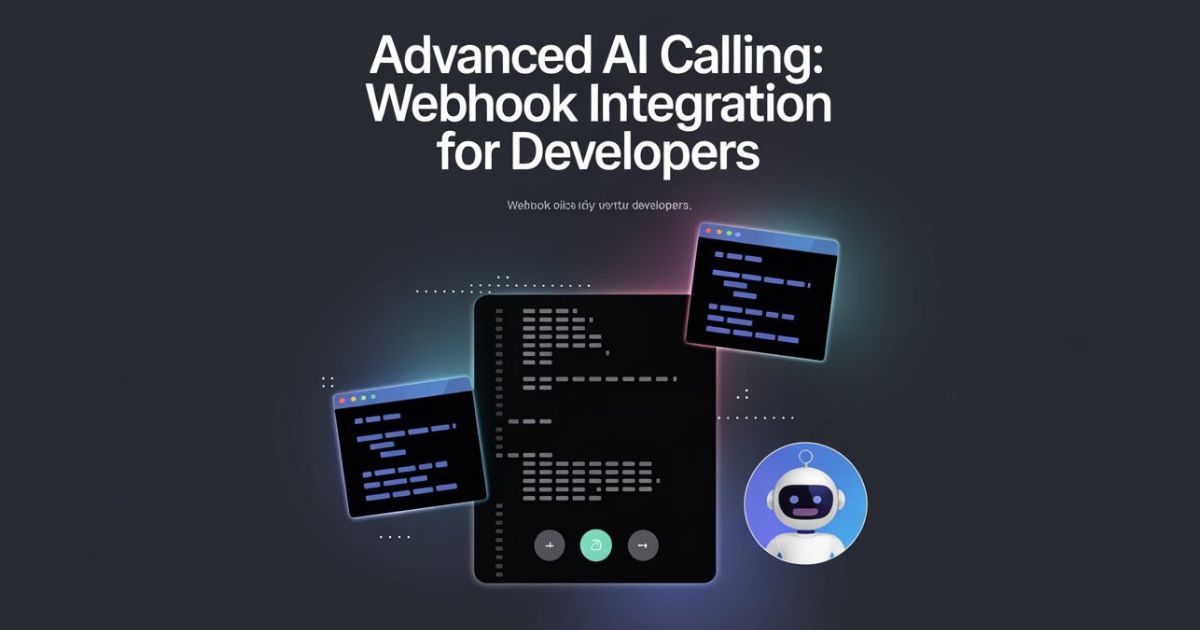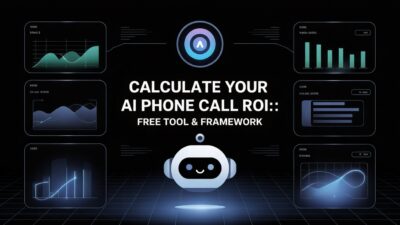Webhook integration AI calling, a powerful combination that enables developers to create sophisticated, automated communication systems that respond in real-time to various triggers and events. The landscape of communication technology has evolved dramatically over the past few years, with artificial intelligence becoming an integral part of how businesses handle customer interactions.
Table of Contents
Webhook integration AI calling represents a paradigm shift from traditional phone systems to intelligent, event-driven communication platforms. This technology allows businesses to automate complex calling scenarios, handle customer inquiries more efficiently, and create seamless experiences that bridge the gap between digital interactions and human conversation.
Understanding Webhook Integration AI Calling
Webhook event triggers for AI call is a sophisticated system that combines the power of artificial intelligence with real-time event notifications to create dynamic, responsive communication solutions. At its core, this technology leverages webhooks—HTTP callbacks that occur when specific events happen—to trigger AI-powered phone calls automatically.
The beauty of webhook integration AI calling lies in its ability to respond instantly to various triggers. Whether it’s a new customer signup, a payment failure, an appointment reminder, or a support ticket escalation, the system can initiate intelligent phone calls without human intervention. This creates a more responsive and efficient communication channel that operates 24/7.
Modern Webhook event triggers for AI call systems utilize advanced natural language processing and machine learning algorithms to conduct meaningful conversations. These AI agents can understand context, handle complex queries, and even adapt their communication style based on the situation or customer profile. The integration aspect ensures that these calls are triggered by real events in your business systems, making them highly relevant and timely.
The Technical Foundation of Webhook Integration AI Calling
Architecture and Components of Webhook Integration AI Calling
The technical architecture of callback URL for AI call events involves several key components working in harmony. The webhook endpoint serves as the listener, constantly monitoring for incoming HTTP requests from various systems. When an event occurs—such as a customer completing a purchase or a service experiencing downtime—the originating system sends a webhook payload to the designated endpoint.
The webhook handler processes this incoming data, extracts relevant information, and determines the appropriate action. In the context of AI calling, this typically involves formatting the data for the AI system and initiating a phone call. The AI calling engine then takes over, using the provided context to conduct an intelligent conversation with the target recipient.
Real-Time Processing and Scalability in Webhook Integration AI Calling
One of the most critical aspects of webhook automation with AI voice is its ability to handle real-time processing at scale. Modern implementations utilize cloud-based infrastructure that can automatically scale to handle thousands of simultaneous webhook events and corresponding AI calls. This scalability ensures that businesses can grow their automated communication capabilities without worrying about infrastructure limitations.
The system’s architecture typically includes load balancers, message queues, and distributed processing systems to ensure reliability and performance. When implemented correctly, AI call flow automation can process events and initiate calls within seconds of the triggering event, creating truly real-time communication experiences.
Implementation Strategies for Webhook Integration AI Calling
Setting Up Webhook Endpoints for AI Calling Systems
The first step in implementing AI call flow automation is establishing robust automation endpoints that can reliably receive and process incoming requests. Developers need to create secure, scalable endpoints that can handle various payload formats and authenticate incoming requests to prevent unauthorized access.
Security is paramount when setting up webhook endpoints for AI calling systems. Implementing proper authentication mechanisms, such as signature verification and API key validation, ensures that only legitimate requests trigger AI calls. Additionally, developers should implement rate limiting and request validation to prevent abuse and ensure system stability.
Designing AI Call Flows in Webhook Integration AI Calling
Creating effective AI call flows requires careful consideration of various scenarios and user interactions. Developers must design conversation trees that can handle different responses, unexpected inputs, and edge cases. The AI system should be programmed to recognize when to escalate calls to human agents and how to gracefully handle situations where it cannot provide adequate assistance.
The design process should also consider the integration of customer data and context. Natural language AI calling systems systems excel when they can access relevant information about the caller, their history, and the specific trigger that initiated the call. This contextual awareness enables more personalized and effective conversations.
Best Practices for Webhook Integration AI Calling
Error Handling and Reliability in AI Call Webhooks
Robust error handling is crucial for any webhook integration AI calling system. Developers should implement comprehensive logging, retry mechanisms, and failure notifications to ensure that important calls are not missed due to temporary system issues. The system should be designed to gracefully handle webhook delivery failures, network timeouts, and AI service unavailability.
Implementing circuit breakers and fallback mechanisms ensures that the system can continue operating even when individual components fail. For critical communications, developers should consider implementing backup notification methods, such as SMS or email, when AI calling fails.
Performance Optimization Techniques for Webhook Integration AI Calling
Optimizing the performance of webhook integration AI calling systems involves several considerations. Database queries should be optimized to quickly retrieve customer information and call history. Caching strategies can significantly improve response times, especially for frequently accessed data like customer profiles and conversation templates.
The AI calling component should be optimized for both speed and quality. This includes fine-tuning models for specific use cases, implementing efficient speech synthesis, and optimizing conversation flows to minimize call duration while maintaining effectiveness.
Security Considerations in Webhook Integration AI Calling
Data Protection and Privacy in AI Calling Integrations
Webhook integration AI calling systems handle sensitive customer data and communication logs, making security a top priority. Developers must implement end-to-end encryption for data transmission, secure storage practices for customer information, and comprehensive access controls to prevent unauthorized access to calling capabilities.
Compliance with regulations such as GDPR, CCPA, and telecommunications regulations is essential. This includes implementing proper consent mechanisms, data retention policies, and the ability to delete customer data upon request. The system should also maintain detailed audit logs of all AI calling activities for compliance and security monitoring purposes.
Authentication and Authorization for Secure Webhook Integration AI Calling
Implementing robust authentication and authorization mechanisms is crucial for webhook integration with AI calling systems. This includes securing webhook endpoints with proper authentication, implementing role-based access controls for system administration, and ensuring that AI calling capabilities are only accessible to authorized systems and users.
Multi-factor authentication should be implemented for administrative access, and API keys should be rotated regularly. The system should also implement rate limiting and abuse detection to prevent unauthorized usage of AI calling capabilities.
Advanced Features and Capabilities of Webhook Integration AI Calling
Intelligent Call Scheduling with Webhook Integration AI Calling
Modern webhook integration AI calling systems can implement intelligent scheduling capabilities that consider factors such as time zones, customer preferences, and optimal calling times. The system can analyze historical data to determine the best times to reach specific customers and automatically schedule calls for maximum effectiveness.
This advanced scheduling capability can also integrate with customer relationship management systems to avoid calling customers during blackout periods or when they have specifically requested not to be contacted. The AI system can learn from successful and unsuccessful call attempts to continuously improve its scheduling algorithms.
Multi-Channel Integration for Enhanced AI Calling Experiences
Webhook integration with AI calling systems can be extended to support multi-channel communication strategies. When a call is unsuccessful or when customers prefer alternative communication methods, the system can automatically fall back to SMS, email, or other channels. This omnichannel approach ensures that important messages reach customers through their preferred communication methods.
The integration can also support escalation workflows where AI calls that require human intervention are automatically routed to appropriate human agents with full context about the customer and the reason for the call.
Monitoring and Analytics in Webhook Integration AI Calling
Performance Metrics and KPIs for Webhook Integration AI Calling Systems
Effective monitoring of webhook integration AI calling systems requires tracking various performance metrics and key performance indicators. This includes webhook delivery success rates, call completion rates, average call duration, and customer satisfaction scores. These metrics provide insights into system performance and help identify areas for improvement.
Advanced analytics can also track conversation quality, AI response accuracy, and customer engagement levels. This data can be used to continuously improve AI models and conversation flows, ensuring that the system becomes more effective over time.
Real-Time Monitoring and Alerts for AI Calling Workflows
Implementing real-time monitoring and alerting systems ensures that issues with webhook integration and AI calling are quickly identified and resolved. This includes monitoring webhook endpoint availability, AI service health, and call quality metrics. Automated alerts can notify administrators of system issues before they impact customer communications.
The monitoring system should also track business metrics such as conversion rates from AI calls, customer satisfaction scores, and resolution rates for different types of calls. This business intelligence helps organizations understand the ROI of their webhook integration AI calling investments.
Future Trends and Innovations
Emerging Technologies
The future of webhook integration AI calling is being shaped by emerging technologies. Like advanced natural language processing, emotion recognition, and improved speech synthesis. These technologies are making AI calls more natural and effective, reducing the gap between AI and human communication capabilities.
Integration with IoT devices and edge computing is also opening new possibilities for webhook integration, AI calling. Smart devices can trigger AI calls based on various conditions, creating more responsive and intelligent communication systems.
Industry Applications
Various industries are finding innovative applications for webhook integration AI calling. Healthcare organizations use it for appointment reminders and medication adherence calls. Financial services implement it for fraud alerts and payment notifications. E-commerce businesses leverage it for order confirmations and delivery updates.
The versatility of webhook integration AI calling makes it applicable to virtually any industry. Industry which needs to communicate with customers in real-time based on specific triggers or events.
Read More: Brand Voice AI: Creating Consistent Phone Experiences
Conclusion

Webhook integration AI calling represents a significant advancement in automated communication technology. It offers businesses the ability to create intelligent, responsive, and scalable communication systems. Organizations can deliver more personalized and efficient customer experiences.
The successful implementation of webhook integration AI calling requires careful planning, robust architecture, and attention to security and performance considerations. Businesses invest in these systems will be well-positioned to meet the growing expectations of customers.
The future of natural language AI calling systems looks promising. With continued improvements in Artificial Inteligence capabilities, better integration options, and expanded use cases across industries. Organizations will have a significant advantage in delivering superior customer experiences and operational efficiency in the years to come.
Webhook integration AI calling will undoubtedly become an essential component of modern business communication strategies. It enable companies to maintain meaningful connections with their customers while automating routine interactions and improving overall operational efficiency.






[…] Read More: Advanced AI Calling: Webhook Integration For Developers […]